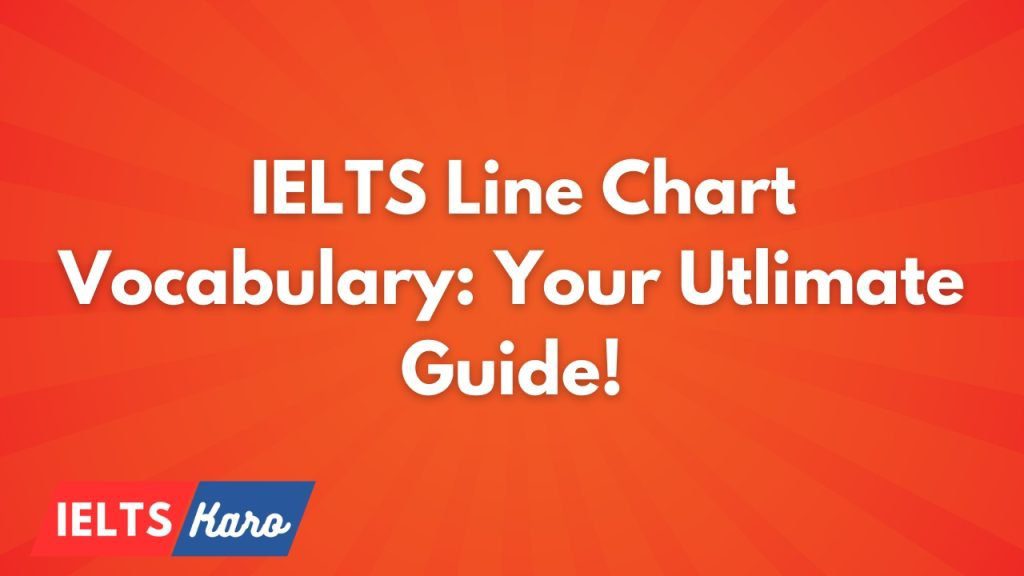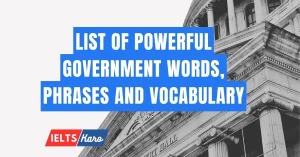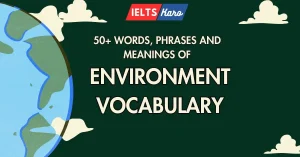The IELTS Line Graph Vocabulary is all about the essential ways such as verbs, nouns, adjectives and adverbs, to describe the line chart in your Writing Task 1 question. A range of vocabulary is another way of saying that you have a STRONG grip over synonyms, or using different words to describe the trends in graphs.
Table of Contents
Limited vocabulary will get you penalised, leading to lower band scores. Not only synonyms remove repetition, they also help in increasing your band score while explaining the upward and downward trends and other key features of the graph or line chart.
The IELTS Line Graphs represent changes over a period of time, such as months, or years. Hence, you need to know what and how to describe these changes using precise words. Here’s a breakdown for the different sections, going beyond just basic verbs and adjectives:
IELTS Line Graph Vocabulary with Verbs and Nouns (Practice)
Here is the list of verbs and nouns to describe the trends in the IELTS line chart and graph. First, let’s understand the introduction. The introduction is the initial paragraph of Task 1, and this is how you can describe it:
- The line graph illustrates…
- The line chart/graph provides information about…
- The line chart/graph shows changes in…
- The line chart/graph compares the number of…
- The line chart/graph depicts the trends in…
Introduction: Opening up
- Understand the nouns: Nouns like “data,” “trends,” and “fluctuations” lay the groundwork.
- Highlight Key Points: Use adjectives like “significant,” “overall,” or “noteworthy” to introduce crucial trends.
- Comparative Analysis (if two lines): Employ contrasting adjectives like “disparate” or “divergent” to showcase differences.
- Verbs that Engage: Move beyond “shows” or “illustrates.” Opt for verbs like “depicts,” “highlights,” or “reveals” to add dynamism.
Example: “The line graph depicts a disparate pattern in computer and mobile phone usage over a five-year period.”
Body: Detailed description of the key trends in graph
- Verbs that Capture Movement: Go beyond the basic “increase” and “decrease.” Use verbs like “surge,” “plummet,” “level off,” or “fluctuate” to depict the nature of the change.
- Adverbs for Precision: Use adverbs for better expression of the data. “Steadily” implies a gradual rise, while “dramatically” signifies a sharp increase. Use adverbs like “marginally” and “steadily” for subtle changes.
- Adjectives that Emphasize Values: Don’t settle for “high” and “low.” Use “peak” for the highest point, “plateau” for a sustained high level, and “lowest” or “trough” for the bottom point.
- Nouns that Define Change: Move beyond just “change.” Use nouns like “growth,” “decline,” “fluctuation,” or “shift” to describe the nature of the data movement.
Here are some verbs you can use to describe the trends in the graph:
- Increase: rise, climb, go up, grow, surge, soar
- Example: “The number of users rose significantly.”
- Decrease: fall, drop, decline, go down, decrease, plummet, plunge
- Example: “The unemployment rate dropped steadily.”
- Stability: remain stable, stay constant, level off, maintain the same level
- Example: “The sales figures remained stable throughout the year.”
- Fluctuation: fluctuate, vary, be erratic
- Example: “The temperature fluctuated over the period.”
Example: “Following a marginal increase in the first quarter, mobile phone usage surged dramatically, surpassing computer usage by the third quarter and reaching a peak in year two.”
Conclusion: Final Words with Key Trends
- Nouns for Significance: Conclude with impactful nouns like “implications,” “significance,” or “overall trend” to emphasize the importance of the data.
- Adjectives for Clarity: Use adjectives like “clear,” “evident,” or “underlying” to leave a final, strong impression of the trends.
- Verbs that Link Ideas: Conclude by linking your observations to a broader concept. Verbs like “suggests,” “indicates,” or “underlines” help tie your analysis to the bigger picture.
Here are some words to open up the concluding paragraph for Task 1 line chart:
- Overall…
- In summary…
- To sum up…
- The general trend is…
- It can be concluded that…
Example: “The clear upward trend in mobile phone usage suggests a growing societal shift towards on-the-go connectivity, with potential implications for future technological advancements.”
Verbs and Adverbs Used to Describe Change
You can use a verb with an adverb to describe the change. Take the following as examples:
- Large changes: significantly, dramatically, considerably, substantially, markedly
- Example: “The population grew significantly between 2000 and 2010.”
- Small changes: slightly, marginally, minimally, modestly
- Example: “The prices increased slightly in June.”
- Medium changes: moderately, steadily, gradually
- Example: “The earnings increased steadily over the decade.”
Here are some more:
| Verb | Adverb | Examples |
|---|---|---|
| Decline | Considerably | The number of visitors to Lahore declined considerably from 1 million in 2020 to 500,000 in 2024. |
| Increase | Dramatically | Average monthly prices for nickel increased dramatically from $2 in 2020 to $8 in 2022. |
| Grow | Steadily | The number of IELTS Academic test-takers grew steadily (have grown steadily) over the last 5 years. |
| Rise | Gradually | The requirements for completing the Ph.D. thesis rose gradually (have been rising gradually) since 2020. |
| Fall | Sharply | The rate of inflation fell sharply (have been/had been falling sharply) from 25% in 2021 to 5% in 2024. |
| Decrease | Slightly | The GDP of Pakistan decreased slightly (have been decreasing/had been decreasing) from $200 billion in 2020 to $190 billion in 2024. |
| Go Up | Rapidly | The number of annual visitors to Faisalabad went up rapidly from 100,000 in 2021 to 500,000 in 2024. |
Remember that the Lexical Resource is 1 of the 4 marking criteria, and it contributes 25% to your overall Writing score. This means that you need to have varying levels of vocabulary to demonstrate your English proficiency level.
Why is Lexical Resource Important?
Imagine painting a picture with words. The more colors (vocabulary) you have on your palette, the more vivid and detailed your description becomes. A strong lexical resource allows you to:
- Express yourself precisely: Writing “increased” is good, but “surged” or “skyrocketed” paints a stronger picture of a dramatic rise, thereby demonstrating your excellent grip over English vocabulary.
- Avoid repetition: Repetition makes your writing boring and monotonous to the reader (also known as the examiner).
- Demonstrate academic proficiency: Less common vocabulary reflects your academic writing skills, a crucial aspect of the IELTS test.
Tips to Enhance Your Lexical Resource:
- Thematic Vocabulary Lists: Create topic-specific lists focusing on line graphs (e.g., trends, values, change).
- Synonyms & Antonyms: Expand your vocabulary by learning synonyms (e.g., increase – surge, decrease – plummet) and antonyms (e.g., rise – fall) to in turn learn the subtle nuances of meaning.
- Collocations: Learn words that naturally go together (e.g., significant increase, dramatic surge) for smoother and more natural-sounding sentences.
- Practice Makes Perfect: Use your newfound vocabulary in practice tests and timed writing exercises. Integrate these words into your regular writing to solidify your understanding.
- Remember, vocabulary alone won’t win the test. Ensure grammatical accuracy and clear sentence structure. Let me know in the comments how useful this list was for you.





